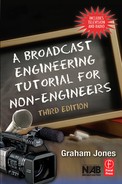Introduction
In its simplest form, a radio or television broadcast station consists of two basic facilities: the studio complex and a transmitter site. The studio complex is the place where the programming originates. The transmitter is the device that, with an antenna, actually broadcasts the program material out over the air. In between the two is a connection called the studio transmitter link. In reality, there are many components that make up the chain from program origination through to the final viewer or listener. This tutorial provides an introduction to the technologies and equipment that constitute modern broadcasting systems.
Traditionally, broadcasting was based on analog techniques, but for more than 20 years there has been a steady migration to digital systems, which provide many benefits for studio operations. The increasing use of computer-based information technology has revolutionized both radio and television studios. More recently, new standards have evolved that now allow digital transmission to the home for both radio and television.
All types of broadcast stations used for domestic broadcasting (AM, FM, and TV) are covered in this tutorial, with descriptions of both analog and digital studio and transmission systems where appropriate. For completeness, satellite, cable, and Internet delivery are also briefly mentioned.
Jargon words and phrases are shown in italics the first time they are used in each section. They may be explained there or covered in detail in other chapters. Some of these jargon words are unique to broadcasting, but some are regular words that are used in a special way—we will try to make their meaning clear for the reader.
Chapters in the first section of the book, Broadcasting Basics, discuss the main methods used for radio and television broadcasting and explain some of the basic science and the terms used later in the book. Chapters in the second section, Studios and Production Facilities, describe radio and television studios and remote operations, covering the main items of equipment used and how they work together. Chapters in the third section, Transmission Standards and Systems, discuss the standards and technologies used for U.S. radio and television transmission, and cover transmitter site facilities and equipment. The final chapter discusses radio wave propagation and the Federal Communications Commission (FCC) Technical Rules.
In each section or chapter, we generally talk about topics related to audio and radio first, and then deal with video and television.
